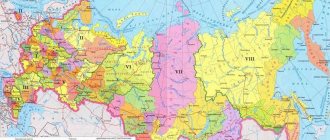Any rights to a land plot must be legalized.
Such rights are subject to state registration by Rosreestr authorities. Registration of the right to use a land plot, the ownership of which belongs to another person, is carried out in any region of Russia, regardless of the location of the land plot.
The complex of registration actions consists of several stages and includes the registrar checking many aspects, starting from the content of documents and ending with the intended purpose and type of permitted use of the land.
What types of land use are there?
Rights to a land plot can take the following forms:
- Rent. The most common form of legalization, which can be used by both citizens and companies for a fee under the conditions specified in the contract;
- Easement. This is a restriction of the right to use land by a person who is not its owner, but has legal grounds for this (for example, the right to place a gas pipeline, water supply; right of passage);
- Free use on an urgent basis. This is the rarest type of legal relationship that arises when an agreement is concluded and the land is the property of its parties;
- Permanent (indefinite) use and the right of lifelong inheritable ownership of land. These types of rights are available only to persons who received such a privilege before 2001, that is, before the adoption of the Land Code of the Russian Federation. Now the land is not formalized in this way, and these forms are gradually losing their relevance.
Modern forms of land use
For its intended purpose:
- build a house or other buildings (structures), depending on the permitted use and regulations for the development of the settlement in the future, in compliance with environmental, sanitary and fire safety standards;
- extract water from underground (wells) or surface sources (ponds) located on the site;
- improve, irrigate or drain the territory;
- grow fruits and vegetables, pets, and raise bees on the property for the needs of the family.
Other:
- transfer land for temporary use for a fee, as a leased item;
- provide land for permanent (indefinite), fixed-term free use or lifetime ownership, with the possibility of inheritance.
When registration is not required
Legalization by entering data into the register is always necessary if this is expressly stated in the law. In particular, the obligation applies to lease agreements and land easement agreements. However, there are exceptions. Registration is not required if the term of the lease agreement does not exceed one year or is concluded for an indefinite period.
The copyright holder who received land for use before January 1998 is also not required to go through the registration procedure, but can do this at his own discretion. Such a right is called pre-existing. However, the lack of state registration of a previously arisen right creates certain risks for the copyright holder. Avoidance of mandatory state registration of a previously acquired right to land does not give rise to legally significant consequences for third parties. That is, the actual owner will not be able to prove his status and protect his interest. In addition, counterparties may be required to take legalization actions in court.
Land lease
Under a land plot lease agreement, the lessor undertakes to provide the tenant with a land plot for a fee for temporary possession and use or for temporary use (Article 606 of the Civil Code of the Russian Federation).
According to Art. 22 of the Land Code of the Russian Federation, owners of land plots, as well as legal representatives of persons under the age of majority, may act as lessors when the latter receives land plots by inheritance (such a land plot can be leased for a period until the heir reaches the age of majority).
In accordance with the law, the essential conditions of a land lease agreement, necessary and sufficient for its conclusion, include, firstly, the subject of the agreement. The agreement must contain data that allows one to definitely establish the property being transferred (to be transferred), i.e. the location, area, intended purpose, category of the plot, cadastral number (before it is assigned, there may be a conditional number) of the land plot must be indicated. A land plot can be transferred under a lease agreement if it is not withdrawn from circulation. The agreement is subject to state registration.
Secondly, the Land Code of the Russian Federation names the amount of rent as an essential condition (Article 65 of the Land Code of the Russian Federation).
If the lease agreement for a privately owned land plot does not specify the procedure, conditions and terms for paying rent, it is considered that the procedure, conditions and terms usually applied when leasing a land plot of similar quality, purpose, location and other characteristics are established.
The procedure for determining the amount of rent, as well as the procedure, conditions and terms for its payment for lands owned by the Russian Federation, its constituent entities or municipal property, are established respectively by the Government of the Russian Federation, government bodies of constituent entities of the Russian Federation, and local government bodies.
The amount of rent for private lands is determined by agreement of the parties. When determining the amount of rent for state and municipal lands, the rates established by the competent authorities (basic rent amounts) are applied. Traditionally, these rates are set per unit area of a leased land plot, taking into account the zone of urban planning value (in settlements), the category of land user, and the type of land use. Rent is expressed in cash, in kind or a combination. It may be charged separately for the leased plot of land or as part of the total rent for all leased property (for example, a plot of land and a building).
As for such a condition of the lease agreement as the term, the current federal legislation has left this issue at the discretion of the parties to the agreement. The only restriction is provided for land plots leased for state or municipal needs or for survey work. The period in these cases is no more than one year. Since the term is not an essential condition of the land lease agreement, it can be concluded either with or without specifying the term. In the latter case, there is an open-ended contract or, more precisely, a contract concluded for an indefinite period. The difference between these types of contracts is manifested primarily in the procedure for their termination. Lease agreements and sublease agreements for a land plot concluded for a period of less than one year are not subject to state registration, except in cases established by federal law.
The tenant has the right, without the consent of the owner of the land plot, but subject to his notification, unless otherwise provided by the agreement, to transfer his rights and obligations under the lease agreement to a third party, including pledging rental rights, making them as a contribution to the authorized capital of a business partnership or society or share contribution to a production cooperative, as well as sublease the leased land within the term of the lease agreement.
The grounds for termination of a land lease agreement are:
- agreement of the parties;
- expiration of the lease agreement (if the lease agreement is not considered renewed) (clause 2 of Article 621 of the Civil Code of the Russian Federation);
- court decision to terminate the contract;
- a request by one of the parties to terminate a lease agreement concluded for an indefinite period.
Early termination of a contract at the initiative of one of the parties is permissible only in court. The grounds for early termination are established in Art. 619, 620 Civil Code of the Russian Federation, art. 46 of the Land Code of the Russian Federation, and may also be provided for in the contract.
Thus, according to the provisions of the Civil Code of the Russian Federation, the tenant may demand termination of the contract if the lessor does not provide him with property or prevents him from using it, if the land plot, due to circumstances for which the tenant is not responsible, turns out to be in a condition unsuitable for use. The lessor has the right to demand termination if, for example, the tenant significantly deteriorates the quality of the land plot and fails to pay rent more than twice in a row after the expiration of the payment period established by the agreement.
According to the norms of the Land Code of the Russian Federation, additional grounds are provided for terminating the lease of a land plot at the initiative of the lessor, namely:
- use of a land plot not in accordance with its intended purpose and category;
- use of land that leads to a significant decrease in the fertility of agricultural land or significant deterioration of the environmental situation;
- failure to eliminate the consequences of a deliberately committed land offense (in the form of poisoning, pollution, damage to land or destruction of fertile soil due to violation of the rules for handling fertilizers, plant growth stimulants, pesticides and other dangerous chemical and biological substances during their storage, use and transportation, resulting in harm human health or the environment);
- non-use of a land plot intended for agricultural production or housing or other construction for the specified purposes for three years, unless a longer period is established by federal law or a land lease agreement, with the exception of the time necessary for the development of the land plot, as well as the time during which the land plot could not be used for its intended purpose due to natural disasters or other circumstances precluding such use;
- seizure of land for state and municipal needs.
These grounds for termination of the lease right, as can be seen, are in the nature of a sanction for a land offense committed.
What are the stages of the procedure for legalizing the right to use land?
Registration of the right to use a land plot begins with the preparation of documents, including drawing up an application and paying the state fee. A legal examination is carried out to determine the reliability and completeness of the information and the compliance of the transaction with the law. After submitting documents for registration, the registrar checks whether there are any contradictions related to the right to use a specific object. After this, the updated data is entered into the Unified State Register of Real Estate, and the applicant receives confirmation of registration in the form of an extract. From this moment on, land rights are considered legal. Refusal to register or suspension entails additional stages, including defending interests in the appeal commission of Rosreestr and the court.
Easement
An easement is the right to limited use of a land plot. This right represents a kind of “right of despair”, the impossibility of not affecting the interests of neighboring land users. In any case, the implementation of the easement should be the least burdensome for the land plot in respect of which it is established. Depending on the grounds for their occurrence and the purposes of their establishment, easements are divided into public and private.
A public easement is established by law or other regulatory legal act of the Russian Federation, its constituent entities, or a regulatory legal act of a local government body without seizure of land plots.
For example, according to the Civil Code of the Russian Federation, public easements can be established by regulatory legal acts of local governments in accordance with urban planning documentation and development rules in cases where this is determined by state or public interests (Article 64).
A public easement is introduced taking into account the results of public hearings. Public easements can be established:
- to pass or drive through a plot of land;
- use of land for the purpose of repairing utility, engineering, electrical and other lines and networks; as well as transport infrastructure facilities;
- placement of boundary and geodetic signs and approaches to them on the land plot;
- carrying out drainage work on the land plot;
- water intake and watering place;
- driving livestock through a plot of land;
- other purposes.
The difference between a public easement and a private one is:
a) in the reasons for its occurrence;
b) the interests not of an individual, but of the state, municipality or local population, that is, an indefinite number of persons benefit from it.
In cases where the establishment of a public easement leads to the impossibility of using a land plot, the owner of the land plot, land user and land owner have the right to demand the withdrawal from him, including through redemption, of this land plot with compensation by the state authority or local government body that established the public easement , losses or provision of an equivalent plot with compensation for losses.
As a general rule, a public easement is gratuitous. The owner has the right to demand from the state authority or local government body that established the easement a proportionate fee if the establishment of a public easement significantly complicates the use of the land plot. Persons whose rights and legitimate interests are affected by a public easement may protect their rights in court (Clause 8 of Article 23 of the Land Code of the Russian Federation).
A private easement is established by agreement of the parties or by court decision. A private easement extends to a neighboring plot of land (which has a common border), and in some cases to another plot (for example, to get to a well, you need to cross several plots of land). It can be installed to ensure passage and travel through a land plot, laying and operating power lines, communications and pipelines, ensuring water supply and land reclamation, as well as for the needs of the owner of real estate (land plot or other real estate), which cannot be provided without the establishment of an easement.
An easement agreement is concluded between the owner of a land plot and the person requiring its establishment. As a general rule, a private easement is of a paid nature; the establishment of a free private easement can only be provided for by federal law, therefore the owner of a plot encumbered by a private easement has the right to demand a proportionate payment from the persons in whose interests it was established.
Since the easement is inseparable from real estate, it is preserved in the event of the transfer of rights to the land plot, which is encumbered by this easement, to another person and cannot be an independent subject of sale, pledge, or transferred in any way to persons who are not the owners of real estate, for ensuring the use of which the easement is established. The holder of the right of limited use of someone else's land plot has the right to perform his own active actions (passage, passage, etc.) and demand from the owner, landowner, land user of someone else's (neighboring) land plot to refrain from certain actions (for example, from creating obstacles to the implementation of the easement). Both private and public easements can be urgent (for a certain period) or indefinite. As a rule, easements are established for an indefinite period.
The grounds for termination of the easement are:
- expiration of the period for which the easement was established;
- agreement of the parties;
- refusal of the holder of the easement from limited use of someone else’s land;
- the grounds provided for in the agreement establishing the easement (for example, payment for the limited use of the site has not been paid within the established period);
- coincidence of ownership of the land plots in respect of which and in the interests of which the easement was established;
- the disappearance of the need, i.e., the grounds on which the easement was granted (or other, in addition to the easement, opportunities to satisfy the needs, interests of the owner of the easement appear, or the interest has disappeared altogether);
- impossibility of using the land plot for its intended purpose as a result of encumbrance with an easement.
In the last two cases, the norms of the Civil Code of the Russian Federation directly establish the right of the owner of a land plot to demand (if the specified grounds exist) the termination of the easement in court. One of the grounds for termination of a public easement is provided for in paragraph 2 of Art. 48 of the Land Code of the Russian Federation: it can be terminated in the absence of public needs for which it was established by adopting an act on the abolition of the easement. The easement comes into force and terminates from the moment of its registration in the Unified State Register of Rights to Real Estate and Transactions with It.
Completed projects
Recognition of ownership of land
In the court of first instance, it was possible to defend the interests of the Principal in the claim of the DGI of Moscow to recognize the ownership of the land plot as absent. According to the DGI of Moscow, the Principal’s plot is located within the city of Moscow (Zelenograd Autonomous Okrug), was not alienated by Moscow to third parties and crosses the boundaries of other land plots owned ... Read more
all projects
Plots: Why are using, managing and owning not the same thing?
In accordance with the provisions of the Civil Code, the buyer of a land plot receives the rights:
- dispose of;
- use;
- own a plot.
These are the three components that determine authority.
You may ask, aren’t these the same thing? No. Ownership status means physical belonging to a specific owner. An asset, unlike ownership, can be used by any person to whom the owner delegates such authority. But in the legal sense, only the owner indicated in the title documents can dispose of the land.
The owner of a land plot can be not only an individual, but also a legal entity. Moreover, there are options for shared ownership, when one plot of land is controlled by individual people in different shares.
Land plots intended for individual construction (IHC) can also be owned by local authorities and municipalities. At the same time, they are able to allocate land to other persons for use, on the basis of long-term lease or lifetime use. This is a type of delegation of ownership.
VRI classifier
The entire list of types of land use in accordance with the law is contained in the VRI classifier. Its purpose is to determine the list of permitted uses of the territory when conducting a certain type of activity.
Land users must always check whether their type of activity corresponds to that indicated in the classifier for a given site.
The classifier contains names, detailed descriptions and codes of activities permitted for each specific territory. VRI is established by local governments. The classifier contains 12 general types of activities and additional clarifying types.
If users have not yet decided on the direction in which the land will be used, then a generalized VRI is initially established, so that in the future it would be possible to use all specified types. Violation of the classifier rules may result in civil consequences (termination of the agreement between the parties) and administrative fines.
The legislation provides for several types of land use. Some of them were installed during the USSR period and ceased to be used with changes in legislation. Land users must comply with the rules specified in the VRI classifier. It contains a detailed description of the types of activities that can be carried out in a specific territory.
Land use subjects
The following may act as land use subjects (according to the current standards of the Land Code):
- individuals;
- legal entities;
- state (local administrations, to whose balance the land was transferred for further disposal).
At the same time, land users, that is, subjects, have their own rights and obligations in relation to the provided land plots.
Rights and obligations of land users
Rights are formed by the act granted, as well as the established features of use under the Land Code of the Russian Federation (and the Civil Code of the Russian Federation, if we are talking about individuals). Responsibilities include:
- compliance with current legislation;
- intended use only;
- construction is permitted only in compliance with sanitary and other standards;
- ensuring free access and travel;
- transfer of information to Rosreestr about current facts of use (when necessary);
- timely commercial payment for the provided land plot (if there is a lease agreement, easement, etc.).
Responsibility for misuse
Responsibility for misuse rests entirely with the user. Soil pollution, construction of buildings that do not meet engineering or sanitary requirements, deforestation, and so on - all commercial losses will be compensated by the user.
The Land Code of the Russian Federation also provides for the possibility of withdrawing land from use if it is not used for its intended purpose. But only judicial bodies have the right to make such decisions.
Features of the use of lands of various categories
Lands of various categories are subject to intended use, that is, the rights granted to users will be strictly limited. But the Land Code enshrines the basic principles by which the rights of subjects (that is, those who act as users) are determined:
- when the site is transferred to use, all existing plants and their derivative elements (seeds, seedlings) become property (but only if this does not contradict legal norms, for example, some trees are strictly prohibited from being cut down);
- carrying out business activities (all manufactured products also fall under the right of ownership, the user can use them at his own discretion within limited legal frameworks);
- natural resources located on the site may be used (for purposes limited by law);
- carrying out construction work if its intended purpose does not contradict the law;
- formation of water bodies (reclamation measures);
- receiving financial and other compensation for the care or cultivation of the plot (more often applied to agricultural land after the cultivation of the site).
We recommend: How to properly divide a private house into shares?
How to draw up an agreement for the division of a land plot Again, the user has the right to demand other compensation established by the legal act under which the land plot is used. But all such conditions must be stipulated either in the lease agreement or in another act (if provided by the local administration).
What responsibility does the land owner have?
By receiving the right to land, the owner receives a share of responsibility with it. In any case, the land plot is located on the territory of the state and is part of the general ecosystem. Therefore, the legislator has the right to assign certain responsibilities to the land owner.
The first thing the site owner must take into account is the rights of other land users.
It should be noted that the state, represented by municipal authorities, allocates suburban land plots for certain types of use. The purpose of the land depends on:
- from geographical location;
- specifics of the allocated lands;
- natural natural purpose.
What does it mean to use a plot of land “for other purposes”?
If you have been allocated a plot for individual housing construction (IHC), then you are obliged to use it strictly for its intended purpose. This means that on the site you cannot:
- build commercial facilities;
- engage in business activities;
- engage in agricultural activities, etc.
Other land plots are allocated for these types of purposes.
If you fail to fulfill your responsibilities to the transferred property, there are consequences. Let's consider a simple example: you decide to build a cottage for permanent residence on a garden plot. Local authorities will not satisfy your request to put the facility into operation. Moreover, the squatter building may be demolished, and you will not be able to resell the land to another owner until all violations are eliminated.
Why is this happening? The construction of a private house must be carried out in accordance with urban planning and architectural standards. Unauthorized buildings may be unsafe, so permits for their operation will not be issued. In addition to these violations, there is also inappropriate use, leading to a decrease in the useful qualities of land resources.










